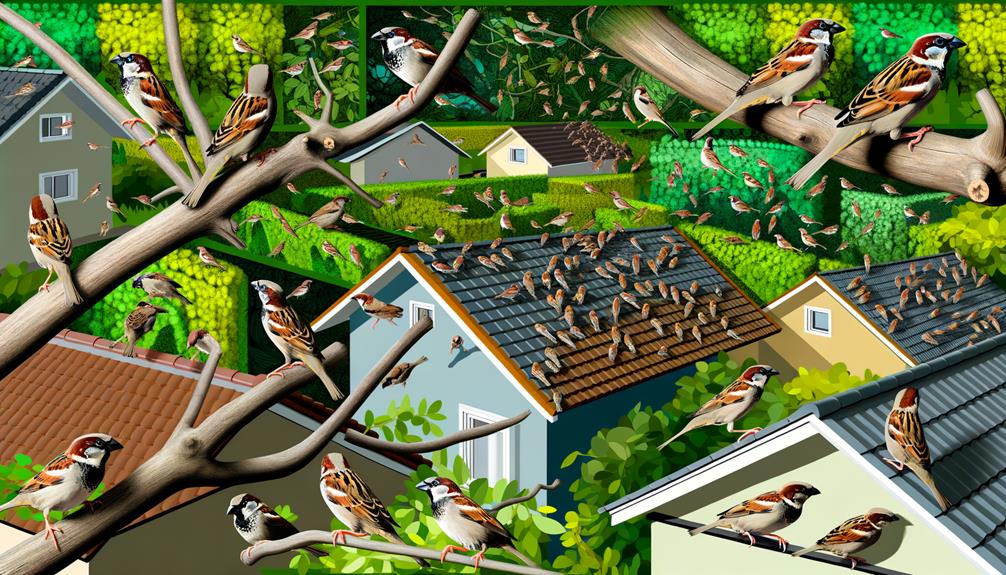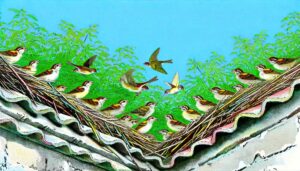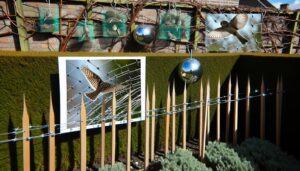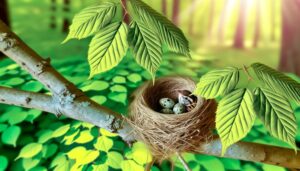Techniques for Attracting House Sparrows with Nest Buildings
You'll find that house sparrows are meticulous builders, choosing nest sites based on safety and food availability. They often prefer cavities in buildings or dense foliage.
Grasses, twigs, and feathers are common materials due to their durability and insulating properties. During construction, sparrows skillfully weave their nests using their dexterous beaks, ensuring the structure is stable and warm.
Seasonal changes influence their material choices, and they regularly maintain nests by replacing worn items and cleaning debris. Their detailed care and precision in building and upkeep reflect an instinctive architectural acumen.
Learn more about their fascinating behaviors and environmental adaptations.

Key Takeaways
- House sparrows use grasses, feathers, and twigs to construct their nests.
- They prefer concealed, elevated sites like cavities, dense foliage, or birdhouses.
- Nest building involves intricate weaving and precise material placement.
- Seasonal changes affect nest location, timing, and materials used.
- Regular nest maintenance includes replacing materials and cleaning debris.
Nest Site Selection

When selecting a nest site, house sparrows exhibit a strong preference for locations that offer both safety from predators and proximity to abundant food sources. They prioritize concealment and elevation to avoid ground-based threats. You'll notice that these birds often choose cavities in buildings, dense foliage, or even birdhouses.
Studies show that house sparrows are highly adaptable, thriving in urban and suburban areas where human activity inadvertently provides protection and food. By understanding their nesting habits, you can create environments that support their needs.
Consider placing nest boxes in sheltered areas with nearby vegetation and bird feeders. This approach not only aids the sparrows but also promotes biodiversity and ecological balance in your community.
Materials Used
House sparrows meticulously gather a variety of materials such as grasses, feathers, and twigs to construct their nests, ensuring both insulation and structural integrity. You'll notice these birds often choose specific items for their thermal properties and durability.
Grasses provide a flexible yet firm foundation, while feathers enhance thermal insulation, essential for egg incubation. Twigs add structural support, creating a sturdy framework.
- Grasses: Flexible and durable, forming the nest's base.
- Feathers: Excellent thermal insulators, maintaining warmth.
- Twigs: Provide rigidity, ensuring nest stability.
Building Process

Sparrows commence their nest-building process by intricately weaving grasses and twigs, creating a robust framework before layering softer materials like feathers. You'll notice how they select pliable grasses for the initial structure, ensuring flexibility and strength.
Their dexterous beaks play an essential role, meticulously threading each piece. Next, they collect feathers, animal fur, and other soft substances for the inner lining, optimizing insulation and comfort for their future offspring.
Observational studies reveal that sparrows exhibit significant precision in material placement, reflecting an innate architectural skill. By understanding these detailed behaviors, you can better appreciate the complexity of their construction methods and contribute to supporting their natural habitats through conservation efforts.
Seasonal Variations
Throughout the year, seasonal variations greatly influence the timing, location, and materials used in sparrow nest-building.
In spring, you'll notice sparrows starting their nests using fresh vegetation and soft grasses, which provide insulation and comfort for hatchlings.
Summer brings an abundance of materials, such as feathers and twigs, enhancing nest structure and stability.
As autumn approaches, sparrows often relocate their nests to more sheltered areas to protect against colder temperatures and adverse weather conditions.
To better understand these seasonal changes, consider:
- Spring: Fresh vegetation, soft grasses for insulation.
- Summer: Abundant materials like feathers and twigs.
- Autumn: Relocation to sheltered areas for weather protection.
Nest Maintenance

In maintaining their nests, sparrows engage in careful activities such as replacing worn materials and cleaning debris to secure a safe environment for their offspring.
You'll observe them constantly foraging for fresh grasses, feathers, and small twigs to reinforce the nest structure. This behavior minimizes the risk of parasite infestations and structural failure.
Sparrows also employ behaviors like dust-bathing and preening to eliminate ectoparasites. Research shows that nest cleanliness directly impacts chick survival rates, emphasizing the importance of these maintenance activities.
By maintaining a hygienic and strong nest, sparrows ensure ideal conditions for their young, showcasing an impressive blend of instinctive care and environmental management.
Your awareness of these practices can inspire more thoughtful stewardship in your community initiatives.
Conclusion
You've seen how house sparrows meticulously select their nest sites, gather diverse materials, and engage in an intricate building process. Seasonal variations influence their strategy, but their commitment to nest maintenance remains unwavering.
It's like watching a well-rehearsed symphony—each bird playing its part with precision. Understanding their behaviors offers you a front-row seat to nature's engineering marvels.
So, next time you spot a modest nest, remember the complex, research-backed saga behind its creation.






